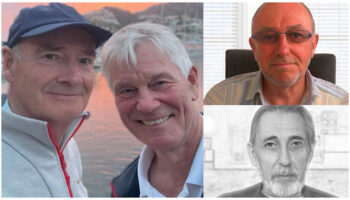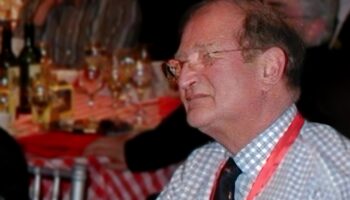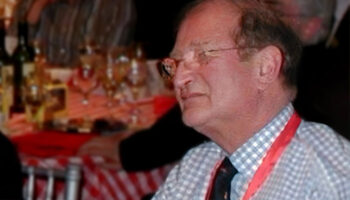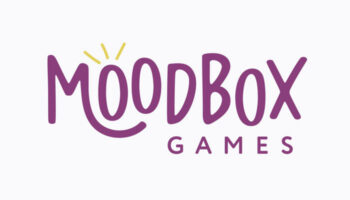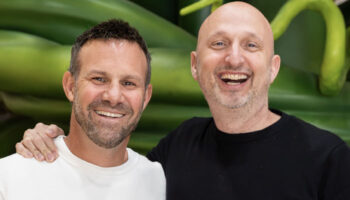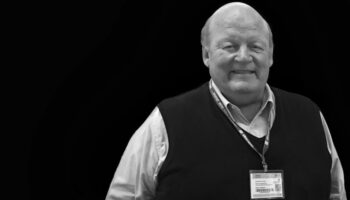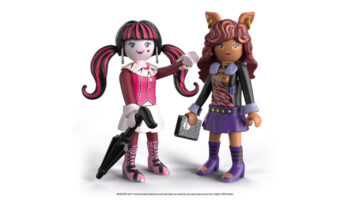Jim Harrison interviews Mike Bucher about his long career in games… And being an I.D.I.O.T.

Bucher & Harrison on Bucher & Harrison: Jim Harrison hears about Mike Bucher’s amazing career.
Ideal, General Mills, Mattel, Spear’s Games, Lone Star Toys, Parker Brothers, Meccano… Your CV is like a roll call of giants! How did you get into the industry, Mike?
After graduating from the Wharton Business School in 1969, I had a lot of job offers, but decided to join the General Mills Toy Group in Minneapolis. I was moved – in 1970 – to the Canadian subsidiary. They handled all the five US companies, at that time, for the Canadian market.
The five US companies being?
Parker Bros, Kenner, Rainbow Toys, Craft Master, and mpc – the model kit people. This gave me an in-depth crash course in the industry, as – due to tariff restrictions – we weren’t only selling a wide range of major US toy and game lines, including products as diverse as Play-Doh and Paint by Numbers, but also manufacturing them in Canada as well. In 1972, I went to France to the Parker Brothers subsidiary, and managed the takeover of the French subsidiaries of the bankrupt Lines Bros.
And Lines Bros. was a huge company at one point…
Yes, they were. Their lines included Meccano, Dinky, Hornby, Scalectrix and Tri-ang. There were multiple factories, offices and ranges to try and co-ordinate, which was quite a task! After that I moved to Amsterdam to become MD for the Benelux, but I was also given the more interesting task of coordinating pan-European game development. At the time, each market had their own versions of key games like Monopoly, Cluedo and so on, with different designs, box sizes, and – in some cases – titles.
You started out as an engineer but ended up working in, and managing, both product design and marketing. Any favourite areas, or is it just all about the product?
An engineer is blessed in the toy industry from imagining a how a rough, crude inventor’s model can become a finished toy or game and motivating a team to do it. In today’s industry, it’s feels like it is all about visual licensed products with less room for creative thinking.

I remember you telling me once about an advertising campaign you ran during a Toy Show in Monaco – remind me how that went?
It was the first World Monopoly Championship in 1977. TV advertising for toys wasn’t allowed on French national television at the time, but I managed to impress the General Mills executives by placing some exciting TV toy spots locally, just on Monte Carlo TV. The station actually had very little reach into France – but they didn’t know that!
Given the many lines you’ve worked on – everything from Star Wars and Trivial Pursuit to Scrabble and Monopoly – I’m sure it’s hard to choose a favourite… Are there one or two that you remember fondly, though?
Trivial Pursuit was a fascinating one. When the game launched in Canada it sold 100,000 pieces in the first year at a very high price point – but I couldn’t get senior management to look at it for the US. They thought it was just another quiz game, of which there were dozens, but I knew there was something different about it…
This is right at the start, then?
Right. Then, at the New York Toy Fair in 1983, I met the inventors. In fact, I got stuck there for two days in a snowstorm! But I persuaded them to license it to us for Europe. General Mills had never done a deal like it: $500,000 advance and a fixed royalty of $2.50 per game was unheard of. Selchow and Righter picked it up for the US and sold a million pieces in the first year – and then 20 million in year two. Unfortunately, cashflow killed the company, and they were bought by Coleco – who then went bankrupt themselves. In the end, Trivial Pursuit ended up at Hasbro – together with Scrabble.
In 1987, I left a company called Lone Star Toys and went to run Habourdin. Habourdin distributed Spear’s Games in France… After that, I became MD of Spear’s. That would’ve been in 1988… I’m also happy that I picked up Scrabble from despair at Spear’s and guided it to become an international icon.
Despair?!
Well! By the late 80s, sales in the UK had declined to about 100,000 pieces a year. I knew just how good the game was – and how well it could sell – from my time in France where it was selling five times as many. But the packaging had been the same over here for 40 years – so we redesigned that. We made the box bigger, added features, reorganised production, and increased the price by 40%.
And the result?
Unit sales more than doubled!

That’s great! And is there, Mike, a brand that you wished you’d been involved in, but weren’t?
Action Man. It’s an immensely creative boys’ toy… It’s not a Ken! But play sets and vehicles to suit the larger scale version of Action Man precluded many affordable possibilities. This was the reason that Kenner went with smaller figures for Star Wars – and the great accessories to suit that scale.
You’ve lived and worked in Europe, the US and the UK, and travelled pretty much everywhere else – do you have a favourite place to live and work?
Amsterdam or Paris, but in the end England – just not London!
Ha! You still work on board games at Tinderbox Games, aka Bucher & Harrison. What do you do there?
After Mattel purchased Spear’s, I stayed with them for three years. I then briefly worked for the Ideal/Majorette/Zapf companies, who were owned by a German private equity group – ostensibly to rationalise the mismatch of each of their subsidiaries. I concluded that the companies would better to concentrate on their individual markets and expertise.
By this time, Mattel had decided to focus all its game development back in the US. As you know, Jim, you had a job offer to go to California – but we talked about it and decided to work together to develop games to licence to, and from, Mattel. Of course, Mattel don’t have the rights to Scrabble in North America, but we thought that we could licence Scrabble variants and language versions in Europe. These products are of lower interest to Mattel… And we’ve been doing this for over 20 years.

We have indeed! And it’s fair to say that the industry has changed massively over those years. In what ways for the better?
The marketing of licensed products and core brands… Just look at Barbie, Hot Wheels, Monopoly and Uno as a few examples. Also, there’s a much broader range of new games in the mass market such as Catan, Jenga, Dobble and Articulate.
And in what ways for the worse?!
For worse… The lack of originality in toys. I think most major new concepts are basically ‘slaves’ of visual media and dependent for success on the media concerned.
Interesting. Great answers! Now, you were honoured – at the UK Inventors Dinner – with an I.D.I.O.T. Award. How meaningful was that at the time? How did you feel?
It was certainly unexpected – and since the dinner was held on a boat floating down the Thames, there was no escape!
Ha! Maybe they planned it that way, Mike! Do you remember what you said in your speech? Whom did you thank?
I don’t recall much of what I said, but I did thank the Product Development team at Spear’s Games. The department at the time – in France and the UK – was about 12 strong and managed by John Reynolds – another I.D.I.O.T. John had previously been at Matchbox. It was a great team, they developed some excellent product, quickly and creatively.
Perfect. I’m just going to interject and say that the Mojo team recently interviewed John Reynolds and say you can read it here. So… You thanked the Product Development team, managed by John Reynolds?
Right. I also made a point of actively encouraging the inventor community –which wasn’t universally the case – by reserving closed rooms at the Nuremburg and New York fairs to receive inventors. It did mean that the team had limited time to see the fairs themselves, but they always managed to get round!
Great. Thanks Mike. We need to start wrapping this up, but – before we finish – can you tell me about something interesting on your desk that people wouldn’t expect?
Ah! Well, the most interesting thing for me on my desk is probably my laptop! Apart from that, there are the medals I won for taking part the VogaLonga in Venice on four occasions.
The Voga…?
VogaLonga! It’s 32km of rowing around the Bay of Venice, and over a thousand boats take part – gondola style and classic! Exhausting, but great fun.
Well, it’s left me speechless! Thank you, Mike.

–
To stay in the loop with the latest news, interviews and features from the world of toy and game design, sign up to our weekly newsletter here



